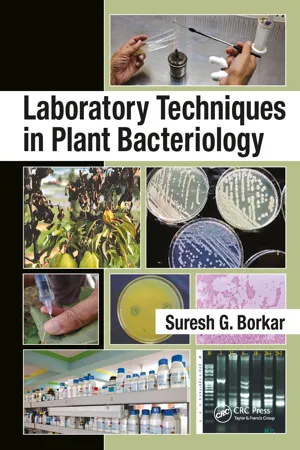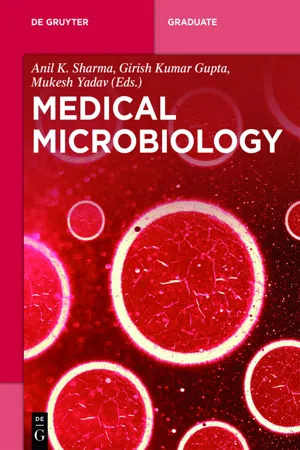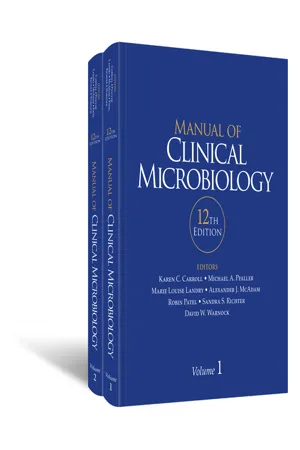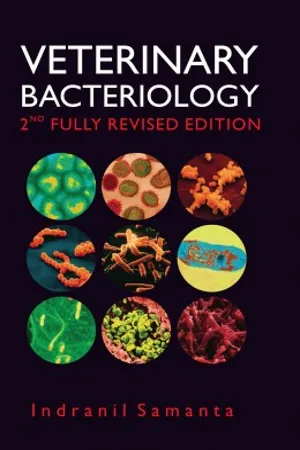Biological Sciences
Acid Fast Stain
Acid-fast stain is a laboratory technique used to identify acid-fast bacteria, such as Mycobacterium species, which have a waxy cell wall that resists conventional staining methods. The stain involves using a lipid-soluble dye, such as carbol fuchsin, which penetrates the cell wall and resists decolorization with acid-alcohol. This allows acid-fast bacteria to retain the dye and appear red or pink under a microscope.
Written by Perlego with AI-assistance
Related key terms
1 of 5
8 Key excerpts on "Acid Fast Stain"
- eBook - ePub
- Suresh G. Borkar(Author)
- 2017(Publication Date)
- CRC Press(Publisher)
Gram staining of bacteria. (Courtesy of Dr. S. G. Borkar and Dr. Nisha Patil, Department of Plant Pathology, Mahatma Phule Krishi Vidyapeeth, Rahuri.)13.5 Acid-Fast Staining of BacteriaThe acid-fast stain is a differential stain. It was developed by Paul Ehrilih in 1882 and was later modified by Franz Ziehl and Friedrich Neelsen. It is used by present-day microbiologists. Bacteria are classified as acid-fast if they retain the primary stain (carbol fuchsin) after washing with strong acid and appear red or as non–acid-fast if they lose their color on washing with acid and counterstained by the methylene blue.The property of acid-fastness appears to be due to the presence of high contents of a lipid called mycolic acid in the cell wall, which makes penetration by stains extremely difficult. In the acid-fast procedure, bacterial smear is treated with carbol fuchsin, followed by heat fixing and treatment with acid alcohol and methylene blue.The acid-fast staining procedure is useful for the identification of members of Mycobacterium , especially in staining of sputum that have Mycobacterium tuberculosis , the cause of tuberculosis, because this bacillus is the only acid-fast organism commonly found in the sputum. M. smegmatis is a nonpathogenic but normal inhabitant of the genitals and may be mistaken for M. tuberculosis in the urine.Material RequiredNutrient agar slants or broth cultures of test bacterium, acid-fast staining reagents, carbol fuchsin, acid–alcohol (3% HCI + 95% alcohol), methylene blue, staining rack, hot plate/water bath, glass slides, Bunsen burner, inoculating loop, blotting paper/absorbent paper, tissue paper, microscope.ProcedurePrepare smears of test bacterium on slides. Air dry and heat fix the smears. Flood smears with carbol fuchsin. Heat the slides to steaming for 3–5 minutes. From time to time, add more stain to prevent smears from becoming dry. Cool slides and wash with distilled water. Decolorize the smear with acid–alcohol for 10–30 seconds or until the smear is a faint pink color. Wash slides with distilled water. Counterstain smears with methylene blue for 1–2 minutes. Wash with distilled water. Blot dry with blotting paper. - eBook - ePub
- Anil K. Sharma, Girish Kumar Gupta, Mukesh Yadav, Anil K. Sharma, Girish Kumar Gupta, Mukesh Yadav(Authors)
- 2022(Publication Date)
- De Gruyter(Publisher)
16 ]. In this staining, basic fuchsin is used as a primary stain. It was used for the first time by Ehrlich in 1882. This method also popularized as the Ziehl–Neelsen method (in the early to mid-1890s). Currently, there are three generally used acid-fast staining methods which include Ziehl–Neelsen (hot) method, Kinyoun (cold) method and the auramine-rhodamine fluorochrome (Truant method).The Ziehl–Neelsen and the Kinyoun methods are more common due to easy observation of the slides developed in these methods using a standard microscope (bright-field microscopy). The Ziehl–Neelsen method is widely used for routine staining. The fluorochrome-based method is widely used by advanced laboratories having fluorescent microscope. It is a heat-based method to impel the primary stain into the waxy cell walls of microbial cells that are otherwise difficult to stain [16 ]. These staining methods are particularly useful for staining Mycobacterium species and also nontuberculous mycobacteria. The cell wall of mycobacteria contains comparatively higher concentration of lipid therefore, cells are hydrophobic and also impermeable to most routine differential stains such as the gram stain. Furthermore, it has also been found that they are resistant to acid and alcohol and can be described as acid-fast bacilli (AFB) or acid alcohol fast bacilli. This staining process distinguishes AFB from acid non-fast bacteria [17 ]. In this staining process, microbial cells are primarily stained with a high-reactive primary stain, that is, carbol fuchsin–phenol. The mycolic acid present with cell binds to carbol fuchsin when it penetrates the cell. The phenol–carbol fuchsin stain is then heated to facilitate the penetration of dye to the waxy mycobacterial cell wall. Due to use of heat, this method is called as the “hot staining” method. The stain binds firmly to the mycolic acid present in the mycobacterial cell wall. Thereafter, an acid-based decolorizing solution is applied. It removes the dye from the sample contents (background cells, tissue fibers and any organisms in the smear) except mycobacteria, which retain or hold fast the dye and, therefore, are termed as AFB. The cells having high amount of mycolic acids [18 ] are tough to decolorize, and therefore, appear pink in color (termed as acid fast organisms). However, non-acid-fast cells are easily decolorized and stained with counter stain, that is, malachite green or methylene blue and therefore, appear green or blue in color, respectively (Figure 6.5 ) - Diwakar, R K(Authors)
- 2018(Publication Date)
- Daya Publishing House(Publisher)
carbol fuchsin. Heating makes the waxy substances to melt and thereby becomes permeable for dye. Thus dye is allowed entry into the cell. On cooling and rinsing with water, waxy substance gets solidifed and seals the pores. Therefore, once stained, the cells resist decolourisation with acid, they are thus ‘acid fast’. It is because the permeability of the cells is increased due to application of heat as a result of the melting of the waxy substances ( e.g. Mycolic acid) and the dye enters into the cells. When the smear cools down, the waxy material again sattles thereby closing the pores. Thus the dye is retained in the cell. In case of non acid-fast organisms, there is no such sealing. Decolourisation is effected with suitable strong acid solution, which allows the draining of the stain out of the cell in case of non-acid fast bacterial cells. The smear is then counterstaind with methylene blue solution. Acid-fast bacteria stain red other bacteria and background stain blue. This method (with 20 per cent sulfuric acid) is used clinically for the detection of Mycobacterium tuberculosis in body tissues and fuids ( e.g. lungs, liver, spleen and urine). D. Special Staining (a) Spore Staining This ebook is exclusively for this university only. Cannot be resold/distributed. Some of the bacteria form spores under unfavorable conditions. The spores are refractile bodies that are resistant to various physical and chemicals agents. The spores may be spherical or oval in morphology and their position within the cell may be terminal, sub terminal or central. The shape, size and position of spores are the characteristic of the spore forming bacteria and are of importance in identification. Spores are refractory to normal staining procedures and if stained are difficult to decolorize. (b) Flagella Staining The motile bacteria posses fagella, which are very thin, thread like appendages present on the cell wall.- eBook - PDF
Mycobacteria
Institute of Medical Laboratory Sciences Monographs
- Maureen V. Chadwick, F. J. Baker(Authors)
- 2013(Publication Date)
- Butterworth-Heinemann(Publisher)
7 Methods for Identify-ing Mycobacteria There are many identification tests available for mycobacteria, but the first screening tests should be those which will rapidly distinguish M. tuberculosis and M. bovis from the atypical mycobacteria. The other identification tests used should be those which will name the atypical mycobacteria associated with human disease or of medical importance down to species level. Several tests are required to identify the mycobacteria, there is no single test. STAINING OF MYCOBACTERIA Certain organisms, particularly the mycobacteria, have the ability of resisting decolorization by acids and alcohols when stained with certain dyes. This property of 'acid fastness' appears to be due to the large amount of lipoids (particularly my colic acid) present on the cell wall of these organisms and causes not only acid fastness but a resistance to ordinary staining methods, such as Gram's stain. Ziehl-Neelsen's Stain Smears The following solutions are required: Carbol fuchsin Basic fuchsin 1 g Absolute alcohol 10 ml 5% phenol in distilled water 100 ml Dissolve the basic fuchsin in alcohol and then combine with the phenol solution. 61 62 MYCOBACTERIA Acid alcohol Hydrochloric acid (s.g. 1-19) 3 ml 95% absolute alcohol (industrial methylated spirit) 97 ml Méthylène blue Méthylène blue 0-5 g Distilled water 100 ml Method 1. Fix smear. 2. Flood the slide with carbol fuchsin and heat (re-heat at intervals) and stain for 10 minutes. 3. Wash in running tap water. 4. Differentiate in 20% sulphuric acid or 3% acid alcohol. 5. Wash in running tap water. 6. Counterstain with méthylène blue for 30 seconds. Wash. 7. Allow to dry and examine with the oil immersion objective. Results Acid-fast bacilli—red. Cell nuclei—blue or green. Sections The following solutions are required: Carbol fuchsin 1% acid alcohol 0-2% méthylène blue or malachite green Method 1. - eBook - PDF
- Robert A. Pollack, Lorraine Findlay, Walter Mondschein, R. Ronald Modesto(Authors)
- 2018(Publication Date)
- Wiley(Publisher)
After preparing the smears as previously described: Place the slide on a wire mesh placed over a beaker of water, which in turn is placed on a heating tripod. Flood the slide with carbol fuchsin stain. Make sure that the entire slide is covered. Heat the water to boiling and allow the slide to remain over the boiling water for 5 minutes (Fig. 5.2). CAUTION: CARBOL FUCHSIN FUMES ARE TOXIC. USE A FUME HOOD IF THE TRADITIONAL METHOD OF HEATING THE SLIDE IS USED. 58 EXERCISE 5 Gram Stain and Acid-Fast Stain SUMMARY • Same as traditional method without heating the slides. LABORATORY CLEANUP INCUBATION Incubate any practice tubes and transfer plates as described in Exercise 2. DISCARDS Discard all tubes and plates not placed in the incubation tray as described in Exercise 2. GENERAL CLEANUP Clean your tabletop and work area, store your lab coat, and put away all equipment as described in Exercises 1 and 2. SLIDES AND MICROSCOPES Store or discard your prepared slides, and clean your microscopes as directed in Exercises 1 and 3. Note: Future exercises will not include a laboratory cleanup section within the text. In future exercises, refer to Exercise 2 for a review of laboratory cleanup procedures. WORKING DEFINITIONS AND TERMS Acid-fast Any microbe that resists decolorization with an acid–alcohol solution. Counterstain The second stain used in differential stains. Cells that display this color are usually considered “negative.” Decolorizer A chemical used to remove the primary stain from some bacterial cells during a differential staining reaction. The microbes that become decolorized are “negative,” and the microbes that retain the primary stain are “positive.” Differential stain Any staining technique that categorizes cells based on how they react to dyes present in the stains. Gram-negative Bacterial cells that take up the counter stain, saf- ranin after the Gram stain procedure is completed. - eBook - ePub
- Karen C. Carroll, Michael A. Pfaller, Marie Louise Landry, Alexander J. McAdam, Robin Patel, Sandra S. Richter, David W. Warnock, Karen C. Carroll, Michael A. Pfaller, Marie Louise Landry, Alexander J. McAdam, Robin Patel, Sandra S. Richter, David W. Warnock(Authors)
- 2019(Publication Date)
- ASM Press(Publisher)
Mycobacterium leprae.Detection of small numbers of acid-fast organisms in clinical specimens is generally significant. However, the use of acid-fast stains for gastric aspirates in the interpretation of pulmonary disease in adults or for stool specimens from HIV-positive patients in diagnosing M. avium-Mycobacterium intracellulare infection yields very poor specificity (false-positive smears with saprophytic organisms) as well as poor sensitivity. In addition, patients receiving adequate therapy may still have positive smears without positive cultures for a number of weeks.Acridine orange stain
Acridine orange is a fluorochrome that can be intercalated into nucleic acid in both the native and the denatured states. Acridine orange is useful in a number of miscellaneous infections, such as Acanthamoeba infections, infectious keratitis, and H. pylori gastritis (11 ). Additionally, it can be used to confirm the presence of bacteria in blood cultures when Gram stain results are questionable or difficult to interpret, especially when the presence of bacteria is suspected but failed to be detected with light microscopy. In the acridine orange staining procedure, the slide is flooded with the acridine orange solution (stock solution, 1 g of dye in 100 ml of water; working solution, 0.5 ml of stock added to 5 ml of 0.2 M acetate buffer [pH 4.0]). The slide is then examined by UV fluorescence microscopy.Auramine-rhodamine stain
Auramine and rhodamine are nonspecific fluorochromes that bind to mycolic acids and that are resistant to decolorization with acid-alcohol. Staining procedures with these fluorochromes are thus equivalent to the fuchsin-based acid-fast procedures (12 ). Acid-fast organisms fluoresce orange-yellow in a black background. If the secondary stain is not used, the organisms will fluoresce a yellow-green color. In this procedure, the slide is heat fixed at 65°C for at least 2 h. It is then stained for 15 min with auramine-rhodamine solution (1.5 g of auramine O, 0.75 g of rhodamine B, 75 ml of glycerol, 10 ml of phenol, and 50 ml of H2 - eBook - PDF
Veterinary Bacteriology
2nd Fully Revised and Enlarged Edition
- Indranil Samanta(Author)
- 2021(Publication Date)
The counter stain (methylene blue / malachite green) is applied to create the contrasting background. Paul Ehrlich (1882) first observed acid fast property of the bacteria and the staining technique. It was improved by Ziehl and Neelsen, so it is currently known as ‘Ziehl and Neelsen’ staining (ZN staining). Later ZN staining was further modified for different purposes as enlisted below. i) Instead of 20% sulfuric acid, 3% hydrochloric acid (HCl) is mixed with 95% ethyl alcohol. This modification is useful to differentiate Mycobacterium tuberculosis from saprophytic Mycobacterium spp. ii) 0.5-1% sulfuric acid is used for demonstration of Nocardia and Actinomyces. iii) < 5% sulfuric acid is used for demonstration of Mycobacterium leprae c) Negative staining: The method of staining the background instead of the microbe is known as ‘negative staining’. The bacteria will appear as stainless / transparent against a coloured background. India ink or nigrosine stains are used for it. The negative staining is useful for detection of spirochaetes, exact cell size and morphology of bacteria. As no heat is applied during the method morphology is not altered. d) Special staining: The special staining is used for demonstration of bacterial parts such as capsule, endospore and flagella. i) Capsule staining: For demonstration of bacterial capsule the background and the bacterial cells are stained with acidic (nigrosine) and basic dyes (crystal violet, safranin, methylene blue), respectively. The capsule appears as unstained halo surrounding the stained bacterial cells. ii) Endospore staining: Bacterial endopsores (produced generally by Gram-positive bacteria with few exceptions) are heat and chemical resistant due to presence of spore coat or exosporium. Malachite green-Schaeffer and Fulton and Dorner methods are commonly used. The spores appear blue and the bacteria appear red in these staining methods. - eBook - PDF
- Osei, Getachew(Authors)
- 2018(Publication Date)
- Agri Horti Press(Publisher)
This ebook is exclusively for this university only. Cannot be resold/distributed. 17 Microscopy: An Introduction An example is the Gram stain technique. This differential technique separates bacteria into two groups, Gram-positive bacteria and Gram-negative bacteria. Crystal violet is first applied, followed by the mordant iodine, which fixes the stain. Then the slide is washed with alcohol, and the Gram-positive bacteria retain the crystal-violet iodine stain; however, the Gram-negative bacteria lose the stain. The Gram-negative bacteria subsequently stain with the safranin dye, the counterstain, used next. These bacteria appear red under the oil-immersion lens, while Gram-positive bacteria appear blue or purple, reflecting the crystal violet retained during the washing step. Fig . The Gram Stain Procedure used for Differentiating Bacteria into Two Groups. Another differential stain technique is the acid-fast technique. This technique differentiates species of Mycobacterium from other bacteria. Heat or a lipid solvent is used to carry the first stain, carbolfuchsin, into the cells. Then the cells are washed with a dilute acid-alcohol solution. Mycobacterium species resist the effect of the acid-alcohol and retain the carbolfuchsin stain. Other bacteria lose the stain and take on the subsequent methylene blue stain. Thus, the acid-fast bacteria appear bright red, while the non-acid-fast bacteria appear blue when observed under oil-immersion microscopy. Other stain techniques seek to identify various bacterial structures of importance. For instance, a special stain technique highlights the flagella of bacteria by coating the flagella with dyes or metals to increase their width.Flagella so stained can then be observed. A special stain technique is used to examine bacterial spores. Malachite green is used with heat to force the stain into the cells and give them colour. A counterstain, safranin, is then used to give colour to the non-sporeforming bacteria.
Index pages curate the most relevant extracts from our library of academic textbooks. They’ve been created using an in-house natural language model (NLM), each adding context and meaning to key research topics.







